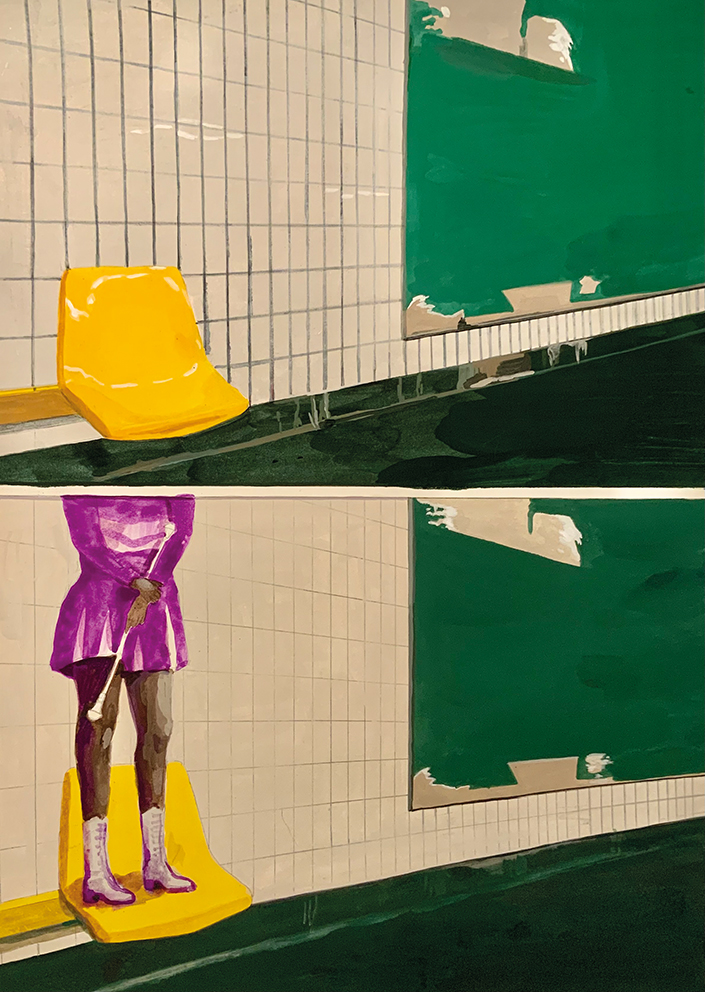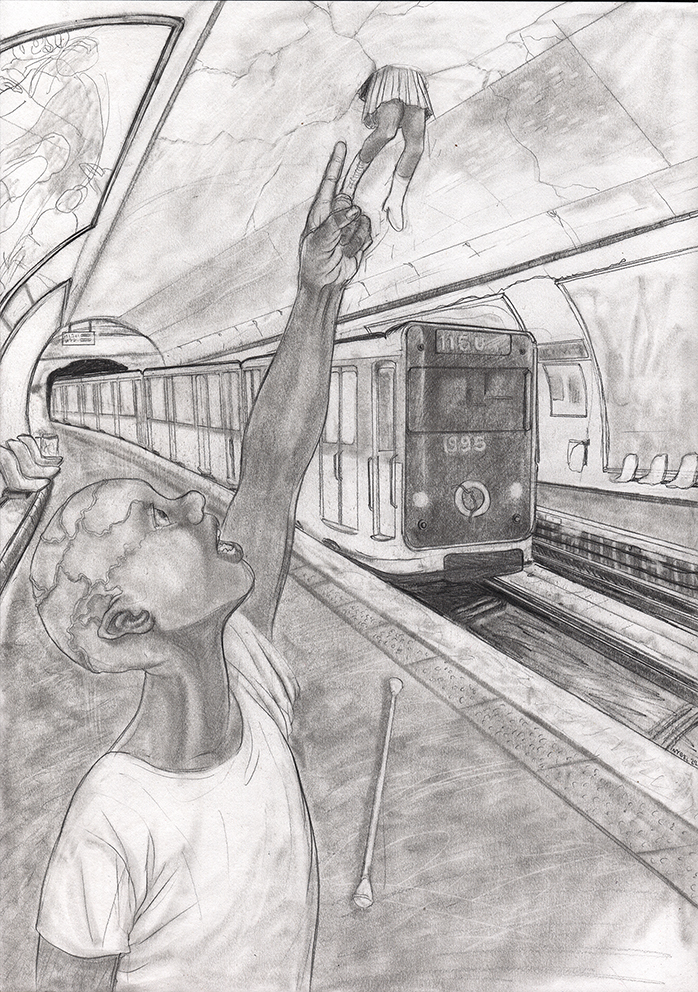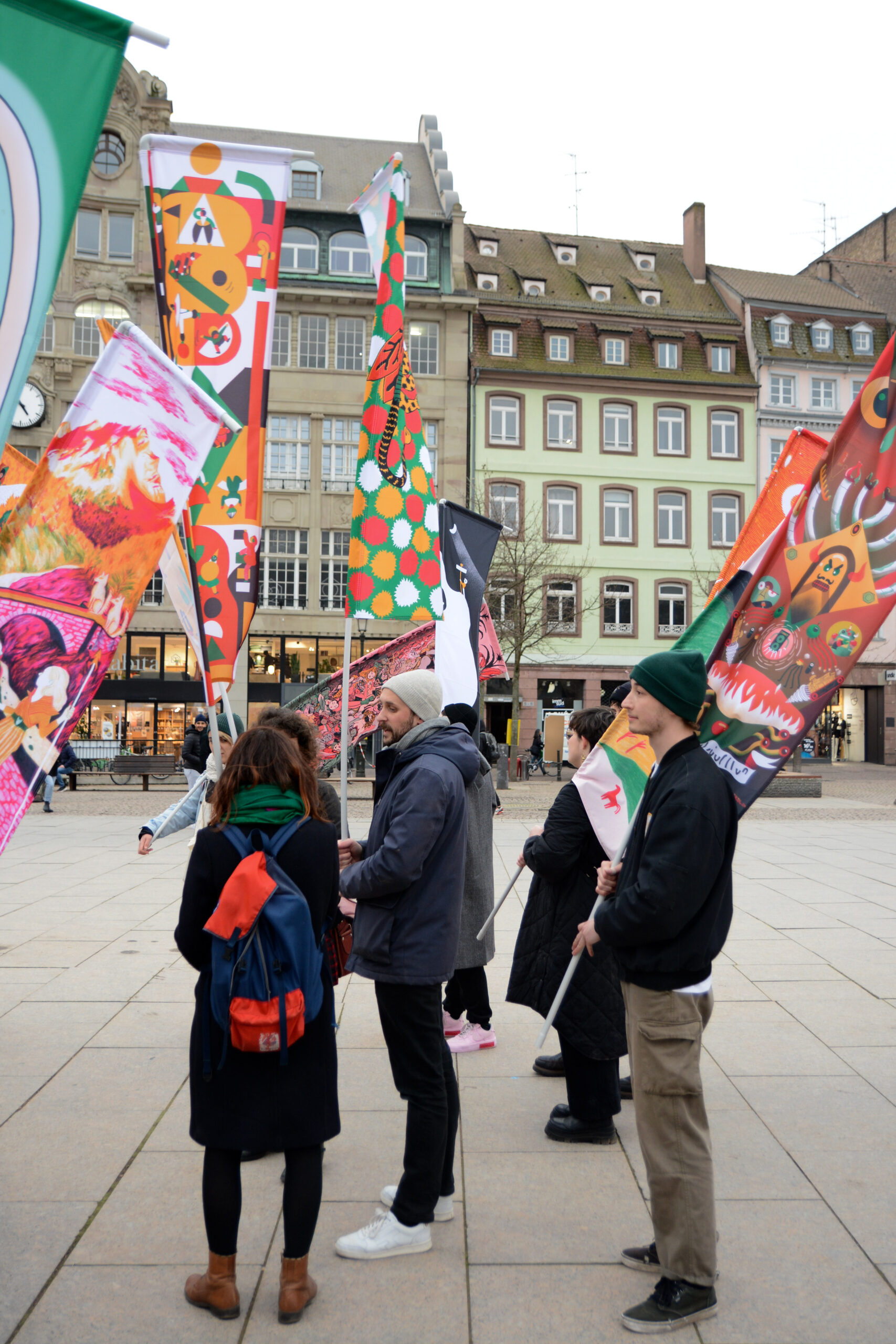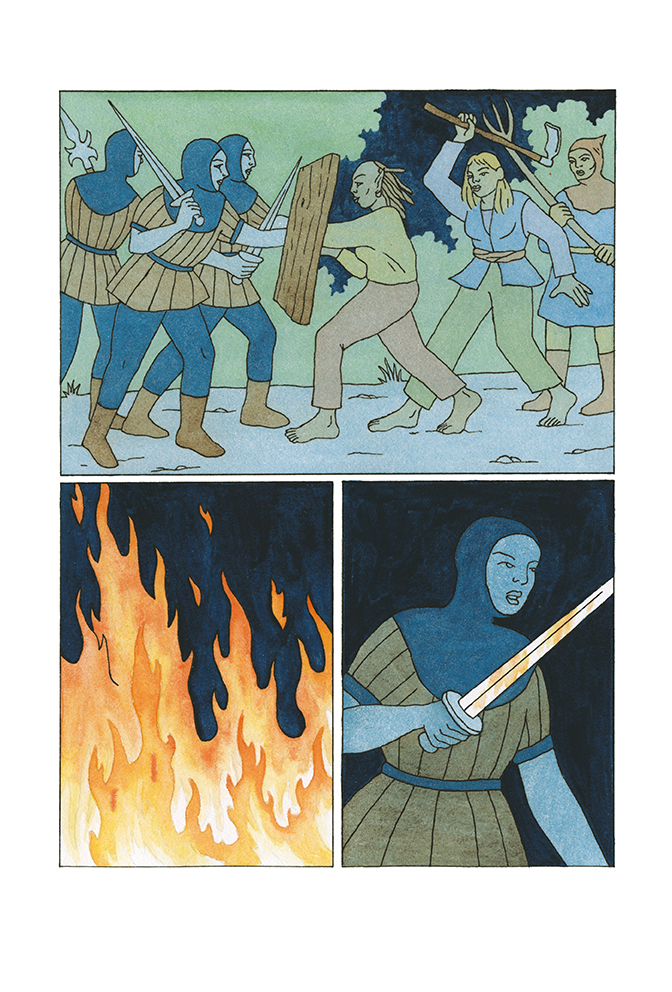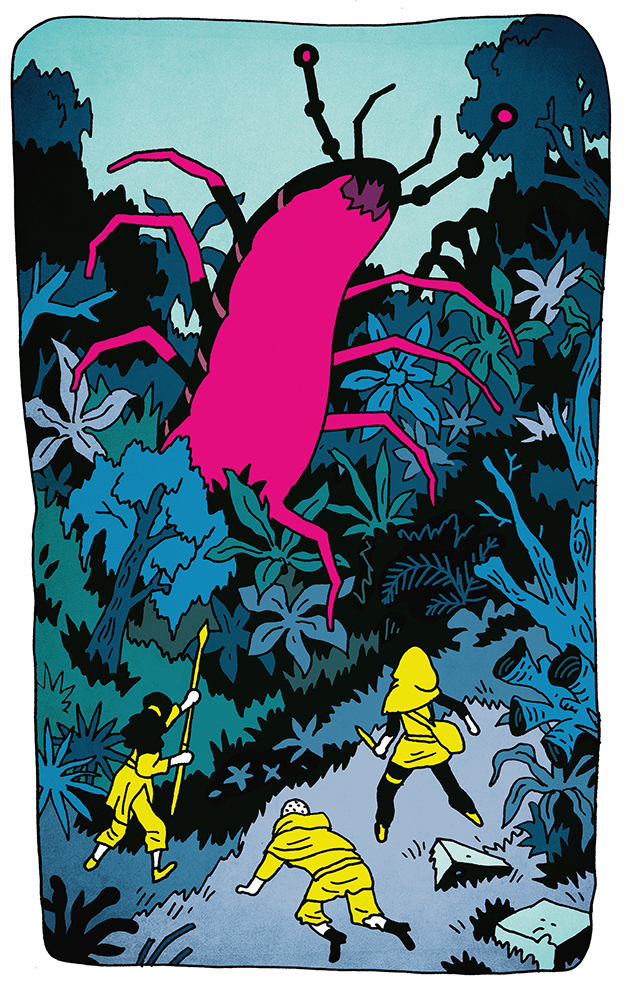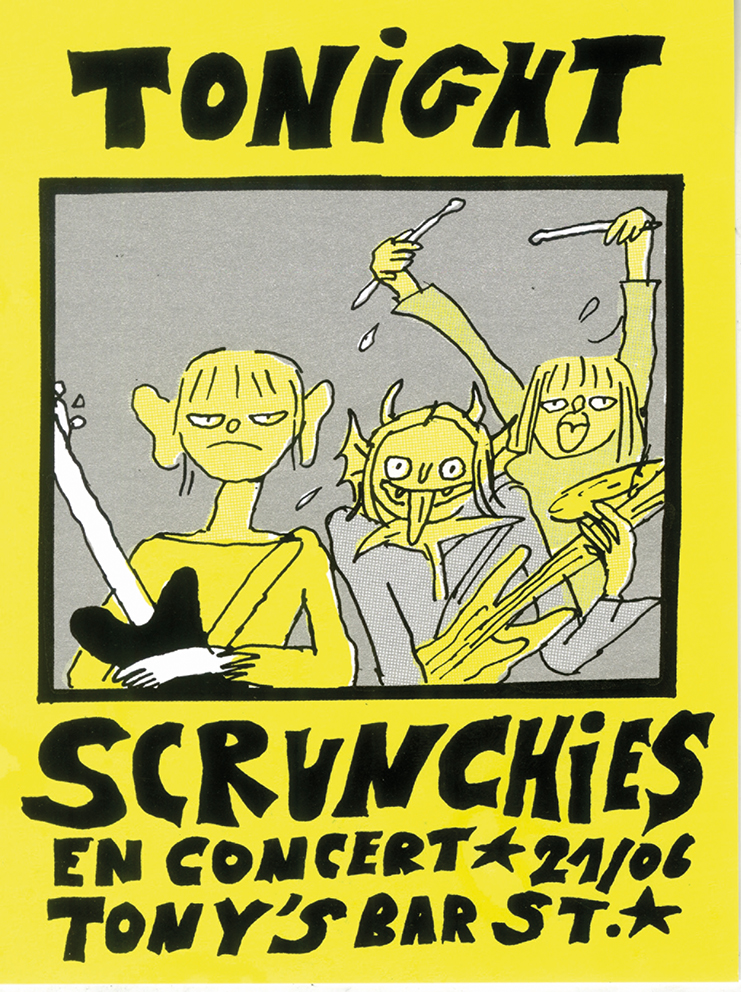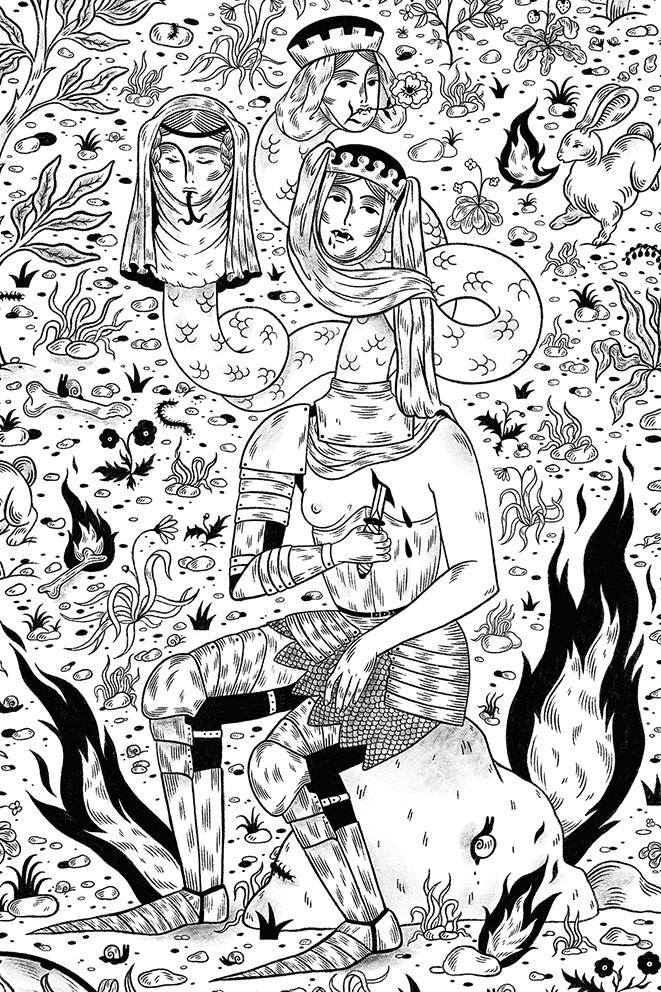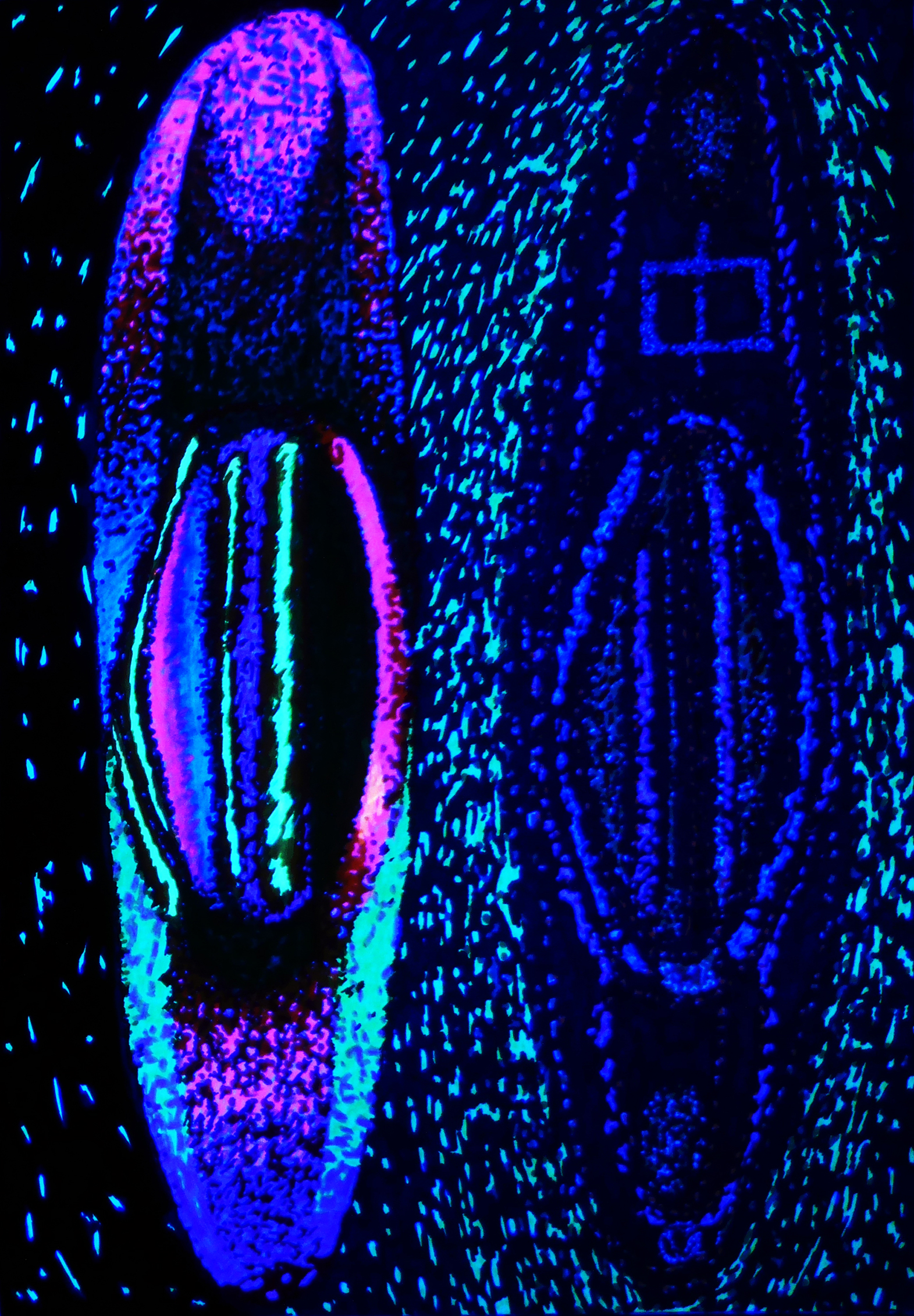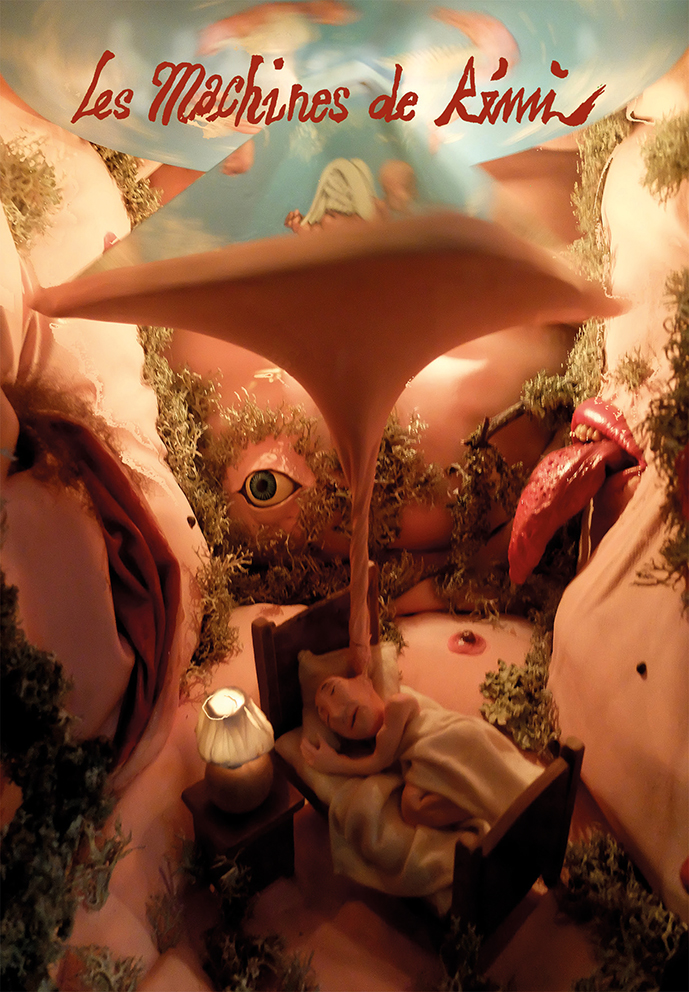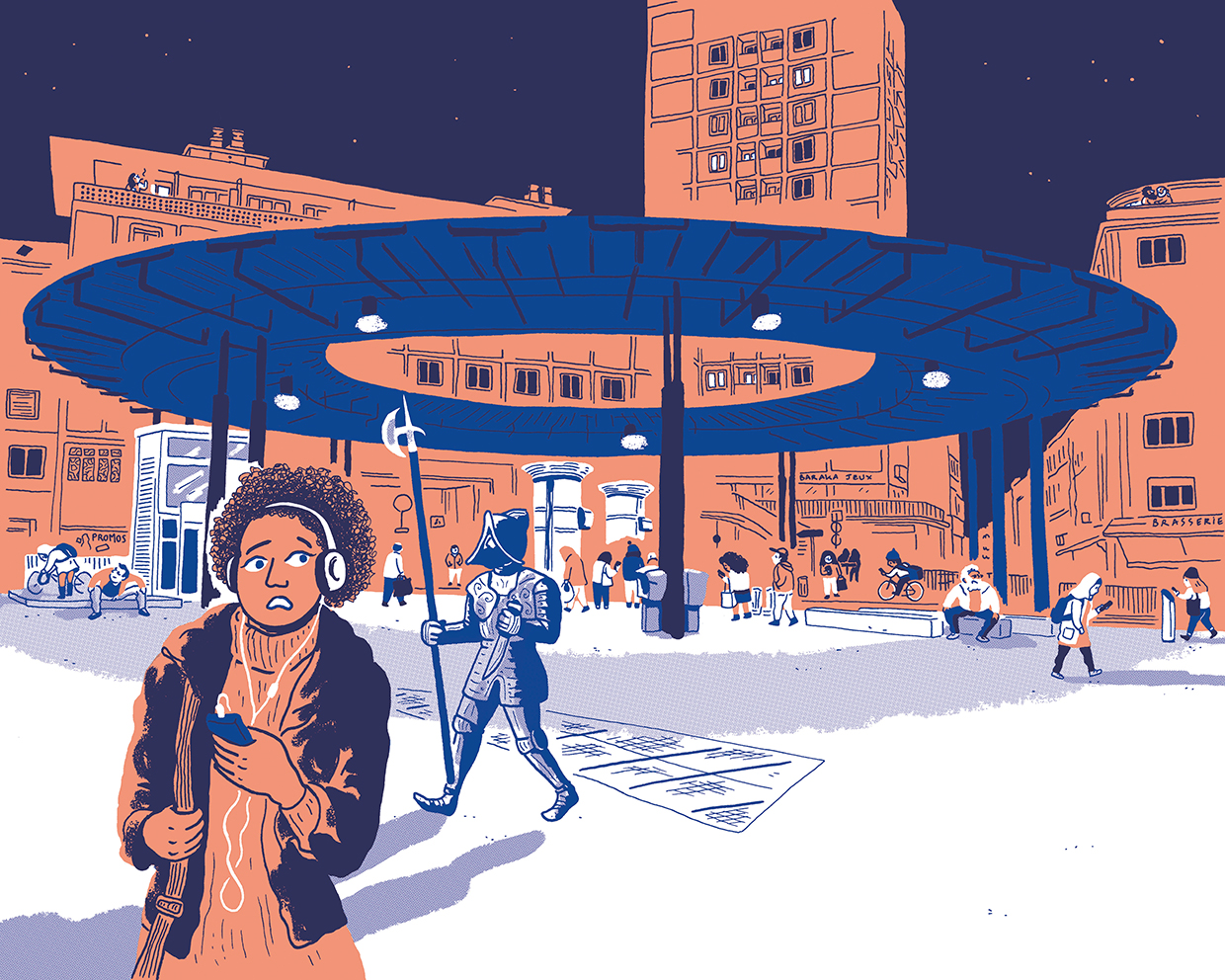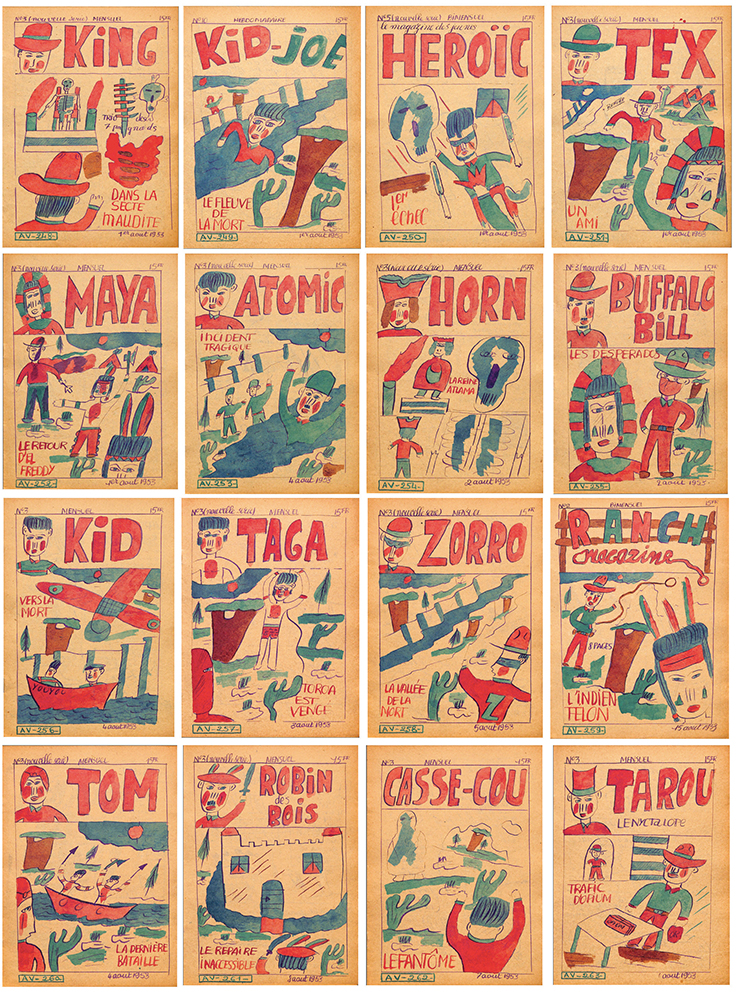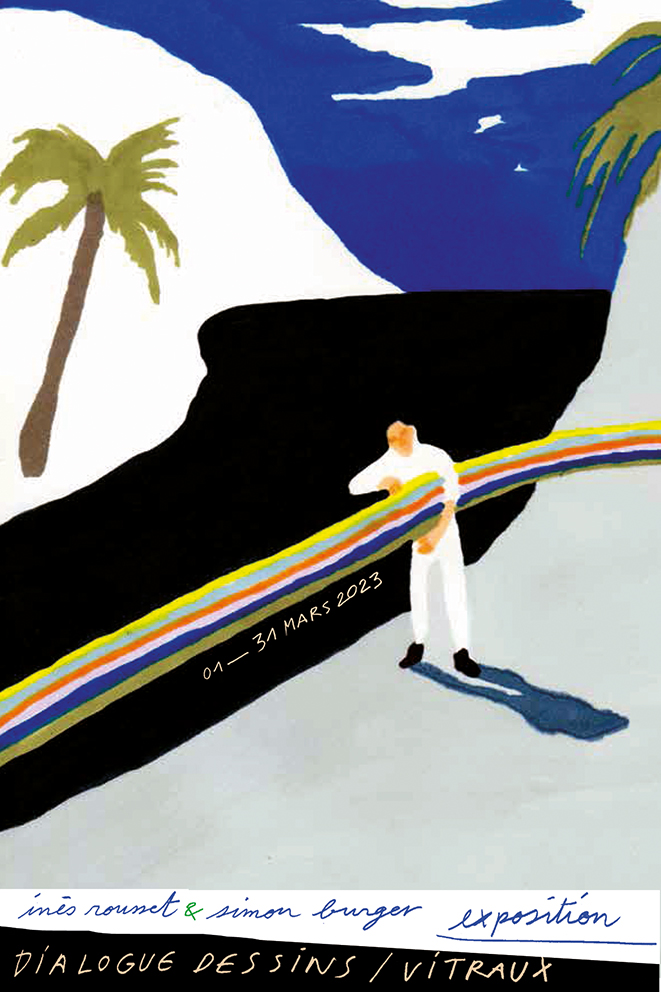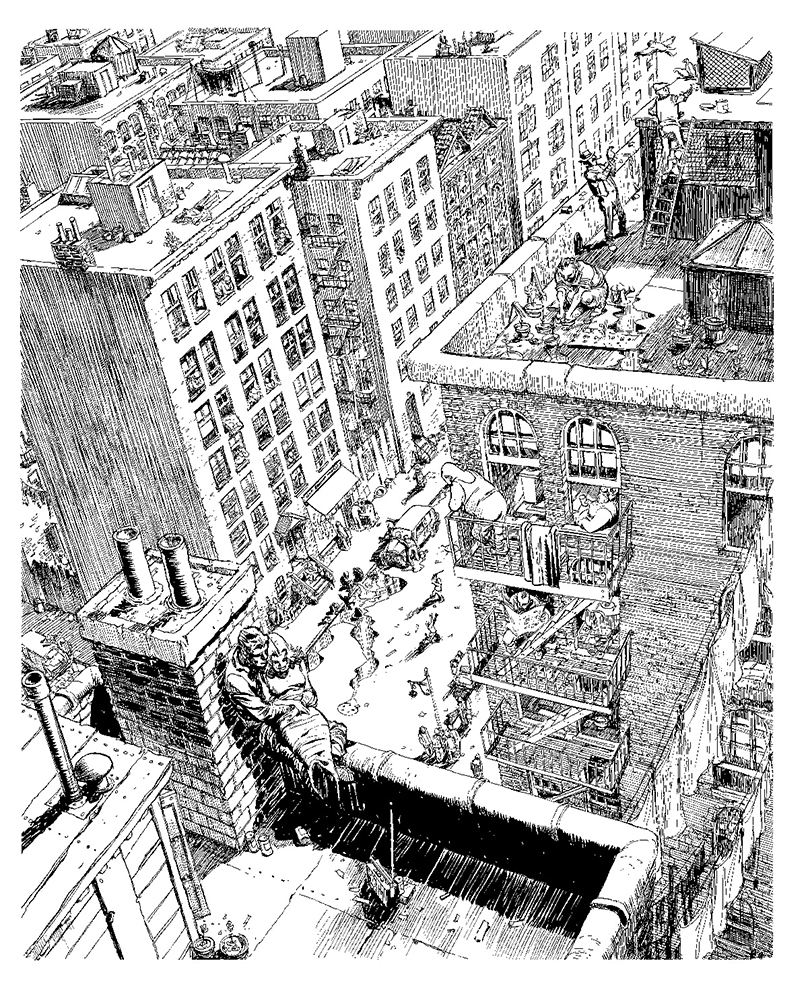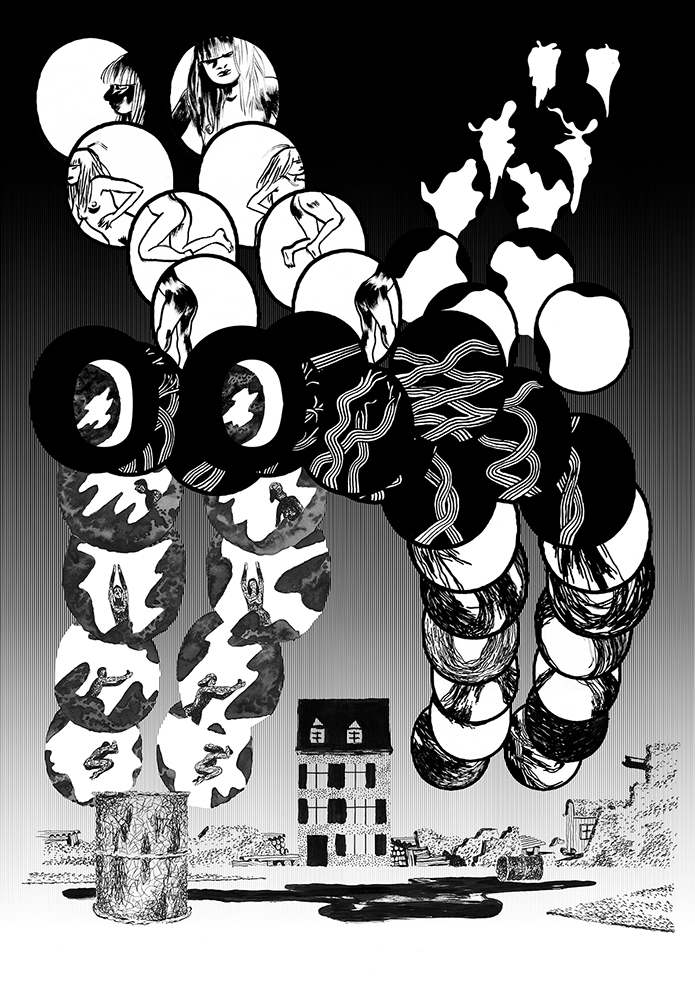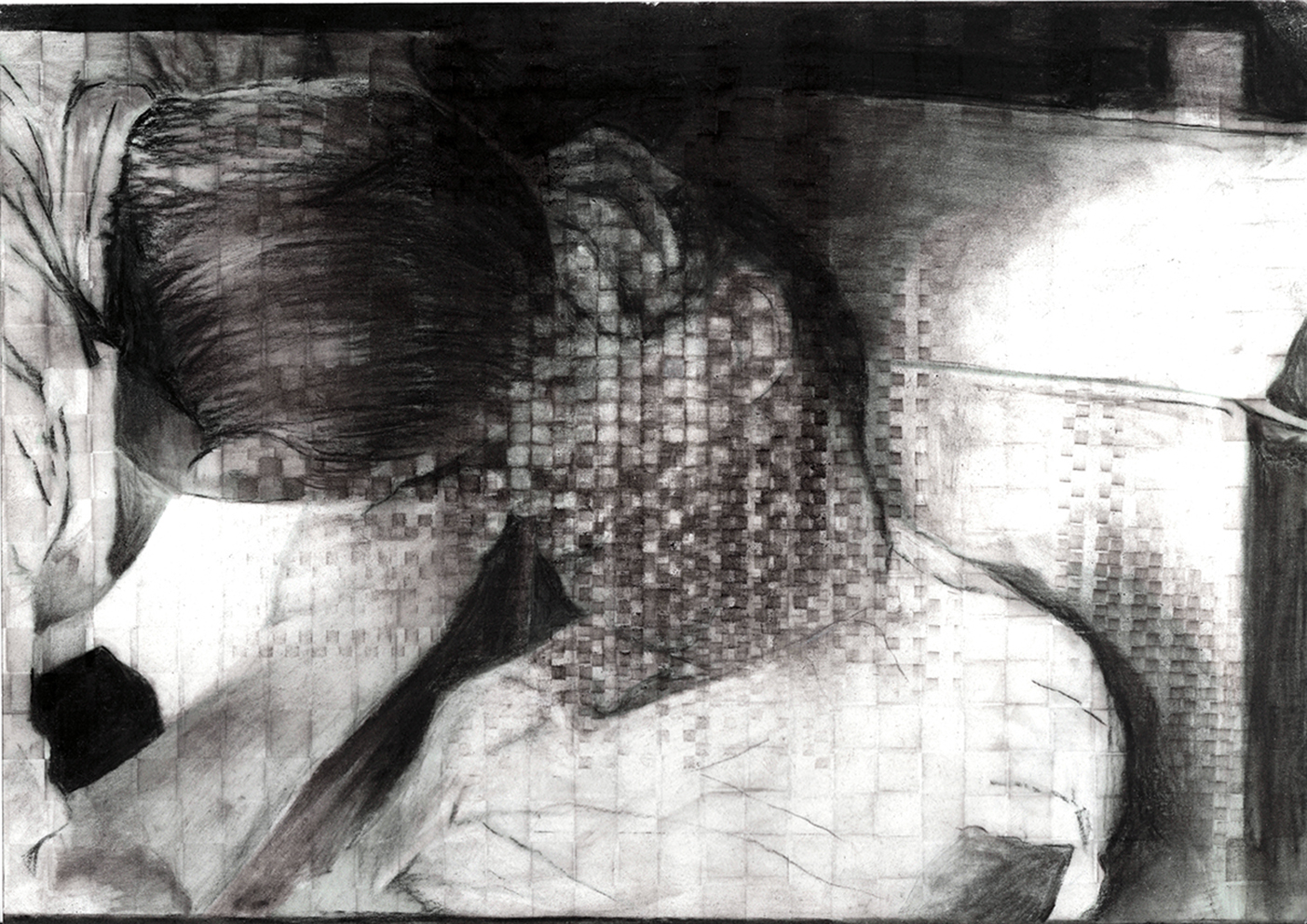Exhibitions
16 March – 02 April
(Thu – Sun) 14H – 19H
Dialogue of drawings 13
Dominique Goblet + Nygel Panasco
Menuiserie Coop — 4 rue de la coopérative
tram d : Port du Rhin
Meeting (animated by Frédéric Verry) > 24 March at 6pm
Opening > 24 March at 6.45pm
Nygel Panasco’s concert > 24 March at 9pm (At Basse-Cour des Miracles)
Our emblematic exhibition brings together the Belgian artist Dominique Goblet and the Strasbourg-Cameroonian Nygel Panasco, also known by this name for her hip-hop solo concerts.
Each year, an established illustrator from across the seas, beyond the Vosges or across the Rhine, dialogues from a distance and in images with a young talent from the Strasbourg region, in two times ten drawings that respond to each other to form a whole with very personal styles. Apart from the A3 format and the scenography, there are no pre-established rules or imposed media, narration if you like, optional text, bubbles and margins.
This dialogue has a restlessness about it, both serene and intranquil, anchored in modern prosaism, floating on a pastorality of all eternity or carried away in parallel universes. Is it Ostend, Paris, Brussels or Strasbourg? The lights are as hypnotic in the crucible of Nygel Panasco’s pencilled greys as they are in the gouaches of Dominique Goblet, on of Dominique Goblet, on the beaches or in the underground worlds. At the centre of this dialogue, a story is told between a child who seems to have come from somewhere else and a majorette who traces her own path.
A catalogue of the Dialogue, with a print run of 200 copies and a foreword by Kai Pfeiffer, is available during the exhibition and at the festival fair.
Nygel Panasco
Born in 1995 in Cameroon, Mireille Nyangono Ebene, aka Nygel Panasco, graduated from HEAR in 2018. She navigates between drawing, music, writing and performance. Her illustration work
questions religion, family, identity, otherness, sexuality and death. She focuses on representations of black bodies and identities, with the aim of making our multifaceted humanity visible. She is self-published, published by Colorama Print (Berlin) and Frankenstein (Milan), Strapazin (Zurich), L’Ennui (Nantes) and participates in events as diverse as the Paris Ass Book Fair, the Comic Festival in Hamburg, the Documenta in Kassel, or the Femfest at the Molodoï in Strasbourg
Dominique Goblet
An illustrator and visual artist from Brussels, in the early 90s she contributed to the creation of the magazine Frigobox where she pursued technical experiments. In 2007, Faire semblant, c’est mentir (L’Association) received the Topffer prize. In 2015 she published Plus si entente (Frémok – Actes Sud BD), the result of several years of exchange with the artist Kai Pfeiffer. With Ostend (2021, Frémok), the artist delivers a series of landscapes of Flanders. In 2020, Dominique Goblet was elected president of the FIBD Grand Jury and also received the Grand Prix Töpffer for her entire career. She regularly exhibits her paintings and sculptures in Belgium and abroad, and in Paris at the Galerie Martel.
March 17
4pm – 6pm
PARADE OF MICRONATIONS
In the streets of Strasbourg:
departure Faubourg National / arrival Place de la République
Forty micronations, created by as many illustrators, will parade through the streets of Strasbourg at the opening of this 13th edition of the Festival.
This year, five new artists – Clémence Démence, Elizabeth Pich, Émilie Plateau, Pauline Morel and Erwann Surcouf – have imagined their own, and their illustrations have enriched the original 2020 collection, imagined for our tenth anniversary. The parade in the urban space will stop at the Tomi Ungerer Museum and will take the visitors of the Catherine Meurisse exhibition to the Bnu for the inauguration of the exhibition La bande dessinée du réel, une nouvelle forme de journalisme? as part of the Rencontres de l’illustration.
16 March – 2 April
Joseph Levacher, Poster route : La légende des champs de feu.
Quai des Bateliers
Signing session > 28 March from 4 to 6 pm at L’Oiseau Rare
This exhibition invites you to discover some pages of La Légende des Champs de Feu, Joseph Levacher’s first book published by Éditions Magnani in 2022. Silence, Tenderness and Courage, flee the valley of the Fields of Fire, corrupted by the arrival of the greedy and tyrannical Mercan. In La Légende des Champs de Feu, these three friends rediscover the forgotten recipe of the leaven of the Fields of Fire and rebuild the lost links with their environment and the people who live there. One question remains: should they go back down to the valley to confront Mercan? The fiction with warm colours and light lines of Joseph Levacher takes on a particular resonance in the Alsace of the lost valleys of the Thirty Years’ War. Cut by the author into twenty large posters and displayed on the Quai des Bateliers, it takes on a new dimension and reserves its ending for the book published by Magnani.
A draughtsman and comic book author from Normandy, Joseph Levacher graduated from the École Estienne and the HEAR in 2021. Author of a “Tarot Païen” game (Éditions Matière Grasse), he participates in several publications with the Passe en Profondeur team and publishes drawings in Culture Physique, Kiblind or Support Magazine. In parallel, Joseph Levacher self-publishes some of his stories, which he prints himself in silkscreen and letterpress.
1 – 31 March
(MON) 14:00-19:00
(TUE – SAT) 10AM-7PM
Célia Housset
La Bouquinette — 28 Rue des Juifs, 67000 Strasbourg
tram c+e+f : République
Signing session > 1 April at 3pm
Célia Housset grew up in the Loire Valley, in a small village surrounded by forests and castles. After an art degree at ESAL-Epinal, he left to work as an illustrator in Strasbourg. Fascinated by folklore, tales and legends, he met the inclusive publishing company On Ne Compte Pas Pour Du Beurre. He illustrated with them the book Il était une autre fois written by the author Anne-Fleur Multon on the theme of traditional tales revisited in a queer and feminist way. The exhibition presents a selection of original paintings from the book.
16 March – 2 April
(THU-SAT) 10am-7pm
ERWANN SURCOUF, Les Sauroctones
Librairie Le Tigre — 36 Quai des Bateliers
tram c+e+f : Gallia
Opening > Tuesday 21 March at 6pm
A graduate of the Arts Déco de Strasbourg in 2000, Erwann Surcouf is the author of comic books mixing fantasy and daily life, such as the trilogy Les Sauroctones (Dargaud). It tells the story of three young people’s picaresque quest through post-apocalyptic France, in search of a mythical rocket. To mark the release of the last volume, the author presents drawings and pencils, a large map and a myriorama printed in riso.
16 March – 2 April
(Wed) 2-6pm
(Thur) 4-10pm
(Fri-Sa) 4pm – 1.30pm
(Sun) 12pm – 6pm
CLARA HERVÉ, The Scrunchies
Orée 85 — 32 impasse de l’écluse
tram a+d : étoile bourse
opening > saturday 18 March at 7pm
Les Scrunchies is a rock band invented by Clara Hervé for her diploma at the HEAR.
Originally the desire to print a t-shirt for a fake festival. Then, as time went by, the Scrunchies group became more and more important: fake flyers, fake vinyl sleeves, fake concert dates… And so it went on, until I wrote the book Before the Scrunch, which tells the story of the band. For the launch of this book, she organised a real-fake concert at the Demi-Douzaine workshop. The Scrunchies have finally moved into the real world, and for their second concert, they still can’t play.
16 March – 2 April
MONA GRANJON, Demi pensionnaires
Atelier Demi-Douzaine — 4 Quai Finkmatt
tram c+f : république
On the occasion of the release of her comic book Demi-pensionnaires, Mona Granjon takes over the window of the Demi-Douzaine workshop to transform it into a school playground. Passers-by will be able to have fun finding the characters from the comic book and other surprises in the middle of a crowd of drawings of pimply teenagers. A sort of Where’s Charlie? with more hormones, Eastpak bags, and notebooks. Mona Granjon graduated from HEAR in 2021. What she likes to do is write characters and put them through embarrassing adventures half inspired by her real life, which is no more glorious.
16 March – 2 April
(Tue-Thu) 10am-12.45pm / 2pm-7pm
(Fri-Sat) 10am-7pm
CHRISTELLE DIALE, Monstresses
L’Oiseau Rare — 23 Quai des Bateliers
tram c+e+f : gallia
opening > tuesday 21 March at 6pm
They practice vengeance in a relaxed way and that’s why we love them. This exhibition presents a selection of illustrations with a common theme: vengeful, vengeful and muscular women inspired by folklore and mythology. An illustrator who has lived in Strasbourg sincesince her graduation from ESAL-Épinal, Christelle Diale unfolds a fantastic, occult and strange universe. She works mainly with graphite and is inspired by medieval and Renaissance imagery as well as figurative painting.
18 March – 2 April
(WED-FRI) 5-8pm
(SAT-SUN) 2-8pm
BÉTONITE, Cave of Doom
La Maison Rose Gruber — 91 Route des Romains
tram f : Comptes
closing > saturday 1 april at 8pm
In the large subterranean bays of the Maison Rose are hidden grey sculptures yellow paintings, green drawings, screens and flashing projections. You can hear purple sounds, walk around brown rocks and blue puddles. Don’t be afraid to open the brown, orange and khaki books, it’s a different story with red. Refer to this text often because the exhibition is in the dark. For more information, see the verses below. For the bilingual, a translation is available elsewhere.
From the cave of the elders
To the bunker of stupidity
The Betonite people paint
And dance under your feet
For a long, long time to come
19 – 25 March
(Thu-Sun) 2pm-7pm
CIE SATIRIX, Les Machines de Rémi
La Basse Cours Des Miracles — 10 Rue du Port du Rhin
Tram d : Port du Rhin
Opening > sunday 19 march at 6pm
In a black box, eight illuminated machines. Cranks invite the spectator to manipulate these optical toys. Finely crafted from recycled materials, these small mechanical theatres form a miniature funfair, both poetic and satirical. Rémi, a cartoonist with an irreverent sense of humour, has found in these pre-cinema optical systems the means to create images that are both fixed and mobile, flat and in relief, beautiful and monstrous. Machines that challenge our prejudices. Machines for thinking.
21 – 30 March
(Mon, Tue, Wed, Fri) : 8am-11pm
(Thu) 3-11pm
(Sat) 9am-7pm
ARIANE PINEL, Dans la place
Le Studium — 2 Rue Blaise Pascal
tram f+c+e : Observatoire
opening > wednesday 22 march at 7pm
Commissioned by the City of Strasbourg for the 5e Lieu, the exhibition is now presented in the brand new Studium library (University of Strasbourg). It consists of a series of two-colour screen prints. The city is seen through “gender glasses”. Can women occupy public space as men do? Are urban developments designed to be to be appropriated by all? The way in which the people of Strasbourg situate themselves, circulate and appropriate these places of life is sketched by the illustrator with humour.
22 – 30 March
(Mon, Tue, Wed, Fri) : 8am-11pm
(Thu) 3-11pm
(Sat) 9am-7pm
Norbert Moutier’s Fanzines
Le Studium, 2 Rue Blaise Pascal
tram f+c+e : Observatoire
The incredible adventure of fanzines made by an Orléans resident from the age of 5 to 19 in the post-war period and discovered in 2020. Xavier Girard, the inventor of this collection of several hundred entirely hand-made titles, opens his treasure chest to the public. He also gives the latest progress in a fascinating ongoing investigation involving family secrets, the comic book industry, nanars, fleas, theatre publishing and a hidden artist. Exhibition of the fanzines in the University Library University Library and presentation of the propaganda film On tue à chaque page ! (1951).
22 March – 24 April
(MON) 9am-6pm
(TUE – SAT) 9am-6pm
INÈS ROUSSET & SIMON BURGER
Avila (salon on the 2nd floor) — 69 rue des Grandes Arcades
tram A+D : Langstross
opening > 31 march at 7pm
The authors are based near Sainte-Marie-aux-Mines, where they have built a silk-screen printing workshop. Inès presents the originals of the book J’ai vu des vêtements sauvages (éditions du Monte-en-l’air): a jaded child who tries as best he can to stop the sea flowing over his elbow, a giantess who does hula-hoop in the night. Simon exhibits stained-glass windows made from silk-screen prints, gelatin, and drawings… paintings that function like little nightclub altars.
Grand Est
11 March – 18 June
(Tue-Sun) 3pm-5pm
WILL EISNER, Graphic Novel Godfather
Cartoonmuseum Basel — st. alban-vorstadt 28 basel / suisse
Reduced admission upon presentation of your Central Vapeur membership card!
Since 1988, the main comic book prize in the United States has been named after him, and since the 2000s, marketing has been applying his invention to anything and everything. The term graphic novel, which was to mark the literary ambition to make a difference with the comic book, was defined by this mythical author and theoretician of the 9th art. Retrospective with a hundred original drawings, photographs and documents.
11 March – 18 June
(Tue-Sun) 3pm-5pm
HECATOMB COLLECTIVE
Cartoonmuseum Basel — st. alban-vorstadt 28 basel / suisse
Reduced admission upon presentation of your Central Vapeur membership card!
Aude Barrio, Antoine Fischer, Yannis La Macchia, Barbara Meuli and Thomas Perrodin form this Geneva-based collective. Keeping control of the book creation process from start to finish has been their mission since 2004. With carte blanche in hand, the artists in residence transform the Cartoonforum into a bubbling mix of participatory laboratory, show and exhibition.
16 March – 14 April
(Wed-Fri) 2-6pm and by appointment
ALEX BESIKIAN
Gallerie My Monkey — 111 rue charles iii
Alex Besikian has developed an aesthetic of improvisation from a world steeped in music since his studies at the Beaux-Arts in Paris, with a music label and two bands to his credit. His publisher, Matière, says of him: “He samples photographs, film images, observed elements, advertising posters, packaging, comic strips. He cuts them out, assembles them and reinterprets them with graphite, ink or coloured pencils.
2 March – 15 April
(Thu-Sat) 2pm-6pm and by appointment
Draw me a picture
Galerie Modulab — 28 rue mazelle
Echoing the contemporary drawing fairs Drawing Now and Ddessin, the exhibition presents new works by three of the gallery’s artists (Irma Kalt, Sandra Plantiveau and Franck Girard)
and three guests (Nicolas Aiello, Aurélie Amiot and Benoît de Mijolla). The title of the exhibition points to drawing as a motif in itself and suggests the desire and timeless intensity contained in this medium.
Until March 26
(Wed-Fri) 2-6pm and by appointment
Vincent Mathy, small specimens 7
Le Signe – Centre National du Graphisme
1 place Émile Goguenheim, Chaumont
For the 7th edition of its youth program, Le Signe welcomes graphic designer and illustrator Vincent Mathy. Through immersive workshops that can be played independently, Petits Specimens 7 invites children and their parents to combine shapes, colors and volumes in order to question the fundamentals of the image while flirting with representation.


